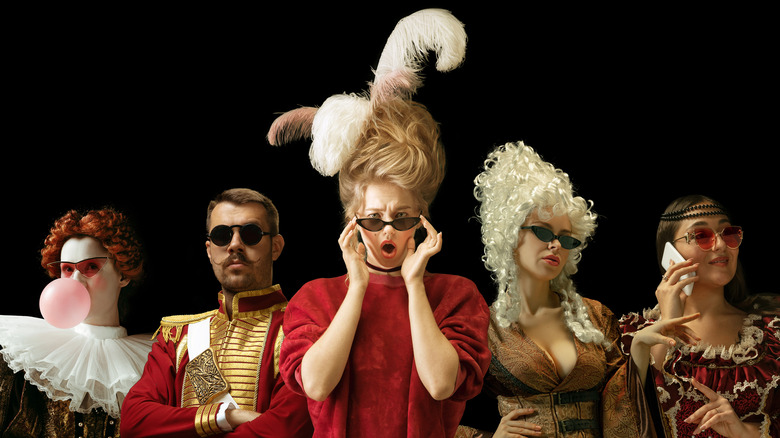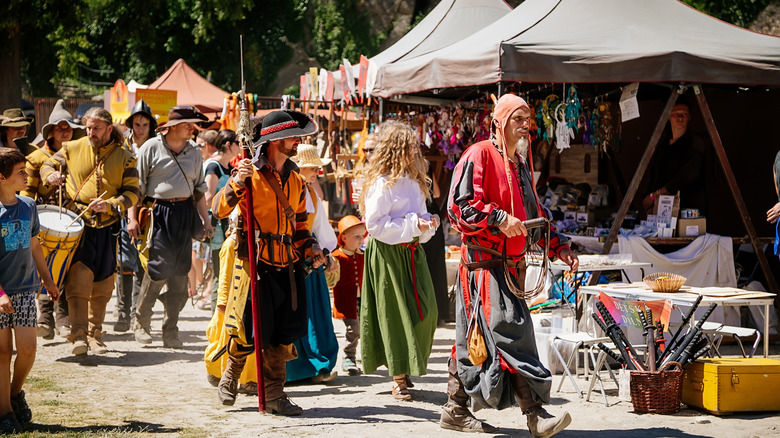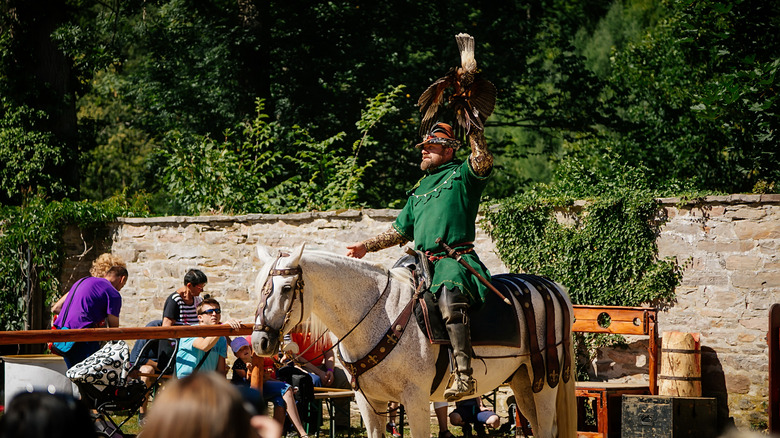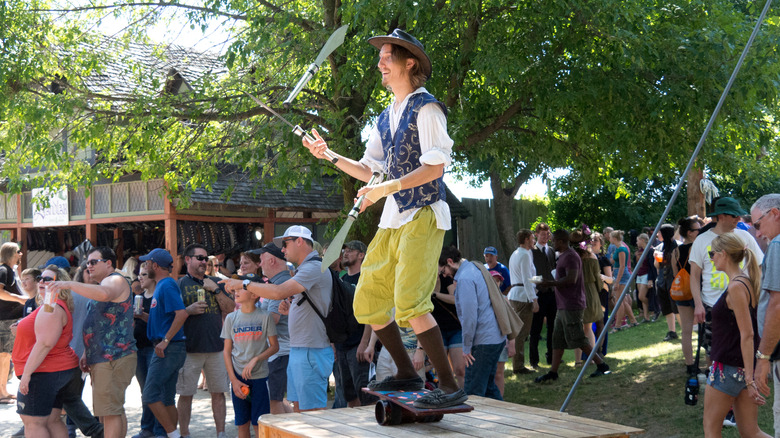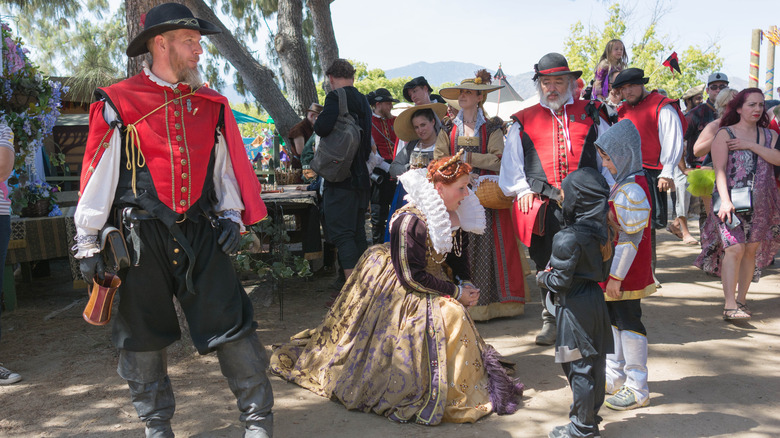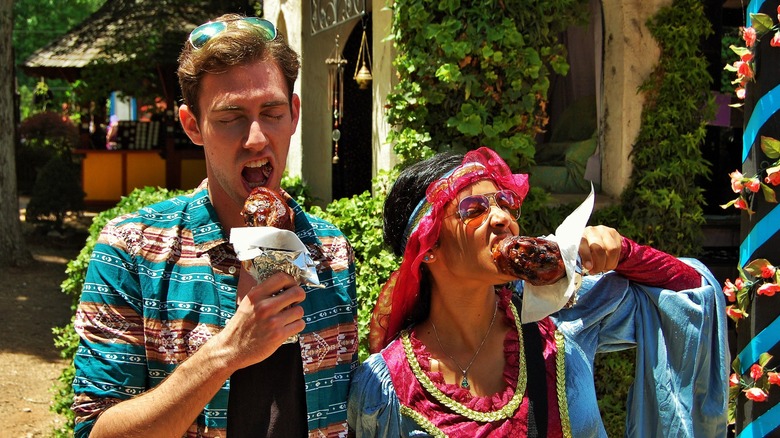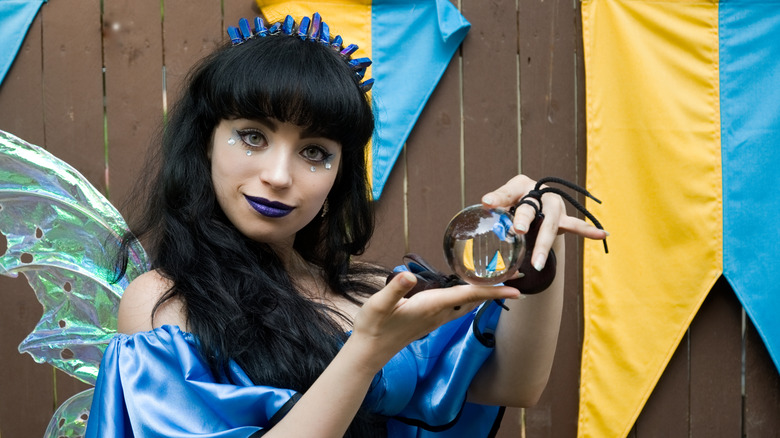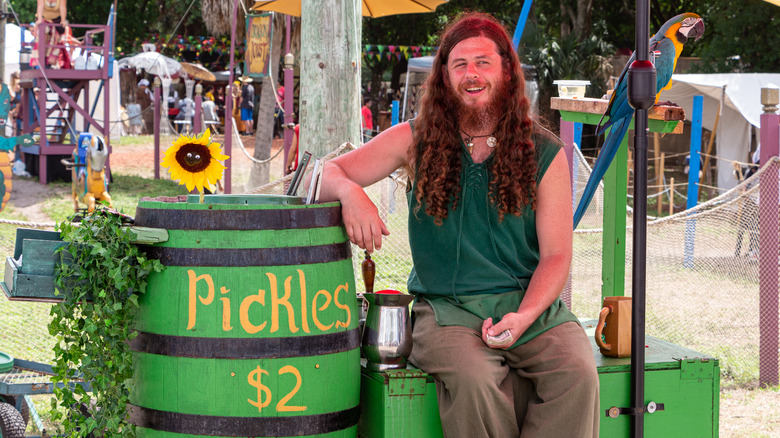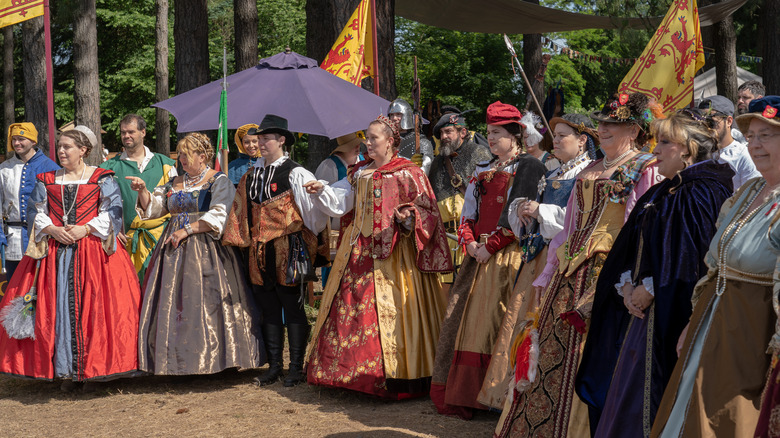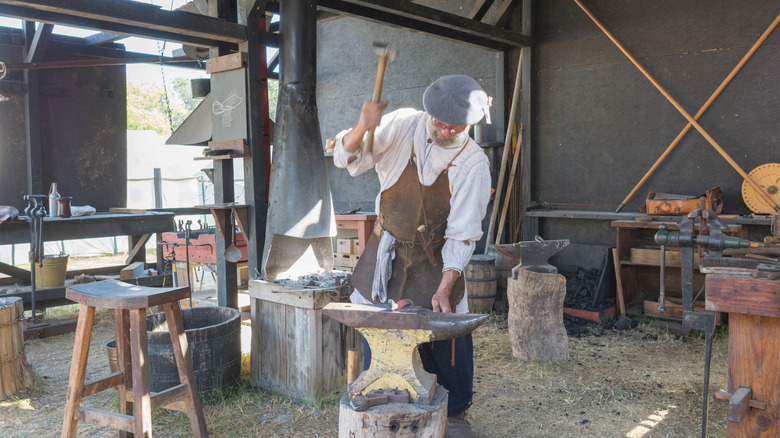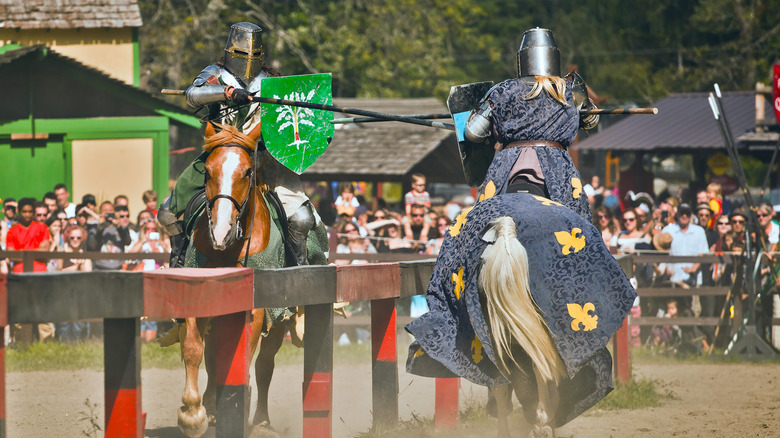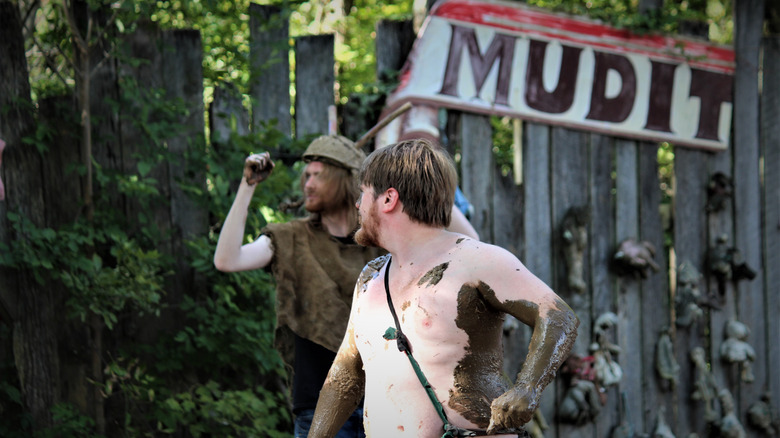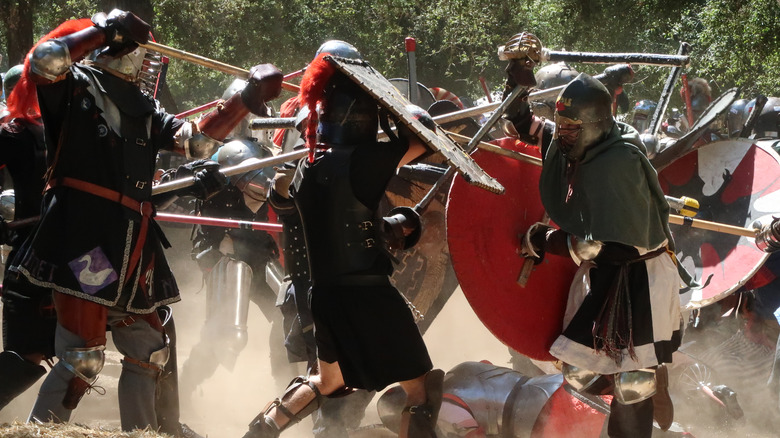Things Renaissance Fairs Get Right And Wrong About History
We may receive a commission on purchases made from links.
Who doesn't like dressing up as a medieval torturer, eating turkey legs, and cracking bawdy jokes in pseudo-Elizabethan English? Renaissance fairs, or festivals, are incredibly popular. "Consuming History" reports that there were at least 170 of these events throughout the U.S. in 2016. There is little debate over whether these fairs are entertaining, but are they historically accurate? Many people who attend Renaissance fairs go with the expectation that they will be immersed in a colorful, historically accurate past filled with swordplay, daring quests, and flagons of mead.
Certainly Renaissance festivals are colorful affairs. However, from human chess games to belly dancing to, yes, even the ubiquitous turkey legs, the historical accuracy of Renaissance festivals is just a bit checkered. Consider the frequent sightings of elves, fairies, and occasional "Star Trek" character impersonators. Were these really apparent in Elizabethan England?
So buckle on your buckler and pull up your pantaloons as we take a look at things Renaissance fairs get right and wrong about history. Let's start by first taking a look at just how these events came to be so popular in the first place.
What exactly is a Renaissance Fair anyway?
At their most cursory level, Renaissance festivals are meant to be immersive experiences which put visitors back into... well... the Renaissance. The New York Renaissance Faire, for example, describes itself as, "a rollicking romp through Elizabethan England, set within the Majestic Groves of Sterling Forest." and invites guests to "travel back in time to an age of adventure! Join Her Majesty, Queen Elizabeth I on a grand visit to a beautiful 16th century English village. Cheer your favorite knight at the Joust Tournament. Meet Robin Hood and his Merry Band. Feast on savory sweets and tempting treats."
Sounds good, but surprisingly, or perhaps unsurprisingly, Renaissance fairs are more children of California's counterculture than offspring of the Tudors. The first of these American inventions was the Renaissance Pleasure Faire of California, founded in 1963 with the intent of providing a "living history" experience. "Well Met: Renaissance Faires and the American Counterculture" describes how the faire's founders, Phyllis and Ron Patterson were inspired by the counterculture. Marine Magazine reported that over 3,000 attended this first event. Soon enough, Renaissance fairs started appearing all throughout the United States and Canada with promises of rollicking romps. Elements of free love, non-binary gender identification, and a general thumbing of the nose at square culture can all be seen at Renaissance fairs today.
Historical accuracy in Renaissance Fairs is highly erratic
Phyllis Paterson, one of the founders of the Renaissance Pleasure Faire, once said to the Los Angeles Times, "We try to bring history to life so that people can actually participate in it and learn something at the same time." She claimed there was authenticity in everything they did.
However, Renaissance festivals should not be confused with venues such as colonial Williamsburg or Plimoth Plantation. These, as explained in "Well Met," are truer to "living history" ideals than Renaissance festivals, which have "never been limited to 'straight' reenactment." This may be because Renaissance fairs have essentially turned into capitalistic ventures. According to "The English Renaissance in Popular Culture," nonprofits that had run some Renaissance festivals such as the Living History Center were bought out by corporations seeking a bottom line. To increase that bottom line, more visitors were necessary. This means that catering to patrons expectations and whims are more central than a commitment to historical accuracy. Thus, as "Well Met" puts it, "virulent nationalism, lack of sanitation, public torture, and religious conflict are erased and nullified, replaced with romanticized combat, a sanitation staff, complimentary parking and good food."
It is telling that one of the major players in the ren faire game is named the Renaissance Entertainment Corporation. So Renaissance festivals need to be looked as a form of entertainment. Some of it is accurate, some is not. It is just erratic.
Renaissance Fairs often don't cover the Renaissance
The Renaissance, according to Britannica, is generally agreed to have begun in the 14th century, peaked in Italy in the 15th century, and spread to the rest of Europe in the two centuries after. While generally the feel of Renaissance fairs captures this era, many conflate different time periods, usually bringing in elements of the Middle Ages, such as Vikings, into the festivals. This can drive a chronologist bananas since it would be like equating the culture of 1800 with that of 2021. It would be like a World War II reenactor of D-day brandishing a matchlock musket.
There are also events at Renaissance festivals that, while fun, don't make a complete amount of sense. For example, many Renaissance fairs, such as the New York Renaissance Faire, offer traditional belly dancing as part of its offerings. Although it is true that the dance has ancient origins, there is no evidence that it was performed in Elizabethan England. At that same festival, we also meet Robin Hood. Now even though Robin Hood probably didn't exist, he is recorded in 14th century literature, and is a product of the medieval period. This is way before Elizabeth I. In this respect, Renaissance festivals are generally a mixed bag but you can usually expect to see a mashup of multiple eras.
The most faithful use historically accurate language
One of the most ubiquitous elements from Renaissance festivals is the use of Elizabethan English by performers, called "rennies." This is typically seen through ample use of the letter "e" at the end of words such as "Ye olde faire" or lots of "miladies, milords, and huzzahs!" One of the most amusing parts of a Renaissance fair is interacting with the rennies by speaking Elizabethan English back to them.
But did people from Renaissance times really talk like that? The answer is sorta.
Often at Renaissance festivals there is what can best be described as hacked Elizabethan English. Rules of grammar do not seem to apply. Rather, the language is a representation of what modern people think Renaissance people sounded like. And the fairs are happy to reinforce those notions. As "Well Met" puts it, this "castle talk" is "words and formulations that invoke Elizabethan English to the American mind without necessarily hewing to its rules of grammar, pronunciation, and social convention." This is not to say it applies universally to all rennies. The more dedicated sorts, as well as the most immersive guests of the festival called "playtrons," may pick up a copy of "A Renaissance Golden Age Language Guide," which is especially geared toward schooling the most dedicated on the Queen's English.
Food at Renaissance fairs is not historically accurate
Aside from vegans and vegetarians, who doesn't like a nice juicy turkey leg? Next to a dragon or a pirate wench, turkey legs are central icons of Renaissance faire. The Texas Renaissance Festival, which according to Businesswire is America's largest, offers a panoply of delights including the Barbarian Inn, Aside from de Leg of Fowl (Turkey leg), the inn offers "tribal taters" and cheese sticks. Heck, there are even Renaissance-themed Greek and Chinese joints at this festival.
While these offerings are delightful for epicureans, for the historically minded they are problematic. Most of these foods were not possible or available in meaningful quantities during the Elizabethan Renaissance. Turkeys, tomatoes, corn, and potatoes are indigenous to the Americas. As pointed out by "News from the Raven," "These foodstuffs were not introduced into Europe until the late sixteenth century, and even after their introduction into Europe, most of these foods, since they were foreign and exotic, did not initially gain popularity to be considered common foods." Some Renaissance festivals openly admit this flaw, such as the Central Coast Renaissance Festival, which posts information on what people really ate in Elizabethan England. This does not prevent them from selling turkey legs.
Fantasy elements at Renaissance fairs are not historically accurate
Probably the most glaring historical inaccuracies at any Renaissance festival are when fantasy elements are put into play. It is not uncommon to see playtrons dressed as elves, pixies, fairies, and wizards. Heck, there are even sightings of Centaurs, which is interesting since these creatures are from ancient Greek mythological traditions. Then of course you have your occasional Starfleet officer streaking through the festival.
From a living history perspective this is preposterous, but "A Modern Nerd's Guide to Renaissance Fairs" looks at it differently, writing, "This can be a fun way to use your imagination and see what you can think up." Clearly, this book takes the side of entertainment over historicity. Again it is a mixed bag. Some fairs encourage the mixing of fantasy fiction with history to create a carnival atmosphere, while some strive to at least retain the trappings of Elizabethan England. As one Renaissance clothing outfitter warns, "DON'T dress as a pirate!, Trekkie, mermaid, elf, unless its' that kind of Renaissance Faire." Sounds like solid advice.
Promiscuity at Renaissance fairs is not historically accurate
Promiscuity, double entendre, and bawdy humor are just par for the course in a Renaissance festival experience. "Eroticism as Embodied Emotion" notes how a Renaissance fair can be sexually charged, asserting that "normative rules of sexual innuendo and expression are suspended." This is not in any way suggesting that Renaissance fairs are sex shows. Rather, there is an undercurrent of innuendo such as when the pickle vendor may say, "Pickles here! I've got a firm, smooth pickle for you!" Such jokes abound and usually dance over the heads of the younger patrons.
So was the Elizabethan Renaissance really filled with pickle hawkers cracking sexual witticisms? The answer is probably not. While there was bawdy humor — and who doesn't know the messed up truth of Henry VIII's domestic life — most people were in very vanilla relationships. "Moral Conceptions of Sexual Love in Elizabethan Comedy" asserts that heterosexual, monogamous relationships were the norm. So why are Renaissance fairs so promiscuous? In part, the answer goes back to the festivals' roots in the counterculture, which pushed for sexual liberation. What better way to do it than to take on a whole new guise of a lascivious rogue or a bawdy washing wench?
Renaissance Fair costuming is sometimes historically accurate
One thing that committed rennies and playtrons pride themselves in is good costuming. Visitors can often even rent costumes upon entry, with one company that works at multiple fairs giving a range of $18 to $65 for an adult costume. Purchasing costumes is of course more expensive, with prices ranging from the tens to well over $1,000.
So are these costumes historically accurate? Let's first exclude the obviously anachronistic options such as centaurs, ogres, wizards, and fairies. And yes maybe belly dancing outfits, too since that wasn't performed in Elizabethan England. So what's left? It really depends on how dedicated the person is to replicating costuming from the Elizabethan era. "Creating the Character Costume" asserts that Renaissance festivals "may focus more on presenting the overall feel of the period, rather than concentrating on strict historical accuracy; while some participants ensure that the materials/techniques used in their garments are as accurate as possible, to share that knowledge of the period with patrons, others are able to utilize a more less loose interpretation of the time period." In short, it's up to you how much you want to pursue historical accuracy, and no-one is going to mind if you go rogue.
Renaissance Fair demonstrations are often historically accurate
Probably the most accurate part of Renaissance festivals are the demonstrations. These have the added bonus of the demonstrator usually breaking out of character to explain and show a certain artisanal craft. In this way, demonstrations at Renaissance fairs come closest to the educational spirit of "living history."
Glass blowing, for example, is one trade that, according to "Extraordinary Jobs for Creative People," has pretty much remained unchanged since antiquity. Blacksmithing demonstrations also concentrate on the historical importance of the craft, even differentiating it from horseshoe making. It should be noted that in these demonstrations, sometimes modern technology is used, say to heat a kiln, but typically the demonstrator explains what modifications she or he has made.
A list of the types of artisanal demonstrations often on offer can be found at the Minnesota Renaissance Festival, which includes candlemaking, pottery, leatherwork, and woodcraft. The Florida Renaissance festival includes demonstrations of sword fighting and the use of the trebuchet.
The violence at Renaissance fairs is sometimes historically accurate
Some of the key highlights of Renaissance fairs are the events and activities associated with warfare. Children get a chance to shoot a bow and arrow, and there are regular matches of steel on steel. Then for the day's climax, you can buy a pickle and go watch a royal joust. Yes, Renaissance festivals provide ample opportunities to watch some truly old school violence. But, are these fights historically accurate?
Again, Renaissance fairs are guilty of combining things from different time periods. "The English Renaissance in Popular Culture" writes that Renaissance fairs "present recreations of historical violence for entertainment and for 'history,' conflating many periods into one as popular spectacle and narrative." Also, fighters rarely if ever carry firearms, which were in use by the late medieval period.
Still, in some events, Renaissance festivals get it right. Jousting, as reported by the New York Times, presents real dangers. In fact, one Australian jouster once partially severed his penis, according to the same source. However, this does not stop the more gung-ho types from wanting to make jousting a professional modern sport. Rules of jousting also seem to pretty much mirror those used during the Renaissance period.
Hygiene at Renaissance fairs is often misrepresentative
At a Renaissance festival, it is common to see performers dressed up in bedraggled, filthy garb. They are usually meant to represent some form of medieval peasant and are making a statement about how the lower classes in this period were just dirty. Aside from wrong-era problems, the trope of the filthy medieval peasant has some problems. The lack of hygiene during the Middle Ages is, at least according to "News from the Raven," a common misconception held by many. While medieval or Renaissance era people did not have germ-theory, powerful disinfectants, or bathed daily, they "would not have appeared in public with dirt on their faces, dirty hands, or unkempt, uncombed hair as they are shown in the movies." The same is true of Renaissance festivals best seen in the highly popular and ubiquitous variations of the "Mud Show." These types of shows involve rennies usually cracking jokes while wallowing around in mud.
Renaissance fairs may not be the best outlet for history nerds
So Renaissance fairs are fun events as long as you are not a nerd about historical accuracy. They are places of escape and entertainment. As Penn Live puts it, "If you're a hardcore history nerd, you might go crazy picking out this weapon or that hairstyle which isn't period. But if you want to have fun, you'll need to chill. Think of it as a chance to re-imagine history."
But if you are a historical nerd, you may want to look at other kinds of outlets such as the Society for Creative Anachronism (SCA). This organization bills itself as an educational association dedicated to "pursuing research and re-creation of pre-seventeenth century skills, arts, combat and culture." The SCA's largest annual event, and definitely not a Renaissance Faire, is the Pennsic War in Pennsylvania. This name, according to Pittsburgh Post-Gazette is a pun on the famous Punic Wars of antiquity between Rome and Carthage. The event sees about 10,000 participants annually who all have to dress in historically accurate pre-17th century garb. They then duke it out with rattan weapons since, as one participant put it, "We want to kill each other. We just don't want to get hurt."
